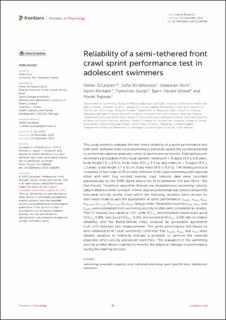| dc.contributor.author | Szczepan, Stefan | |
| dc.contributor.author | Wróblewska, Zofia | |
| dc.contributor.author | Klich, Sebastian | |
| dc.contributor.author | Michalik, Kamil | |
| dc.contributor.author | Gonjo, Tomohiro | |
| dc.contributor.author | Olstad, Bjørn Harald | |
| dc.contributor.author | Rejman, Marek | |
| dc.date.accessioned | 2024-03-18T07:33:15Z | |
| dc.date.available | 2024-03-18T07:33:15Z | |
| dc.date.created | 2024-01-12T12:38:08Z | |
| dc.date.issued | 2023 | |
| dc.identifier.citation | Frontiers in Physiology. 2023, 14, Artikkel 1260346. | en_US |
| dc.identifier.issn | 1664-042X | |
| dc.identifier.uri | https://hdl.handle.net/11250/3122767 | |
| dc.description | This is an open-access article distributed under the terms of the Creative Commons Attribution License (CC BY). The use, distribution or reproduction in other forums is permitted, provided the original author(s) and the copyright owner(s) are credited and that the original publication in this journal is cited, in accordance with accepted academic practice. No use, distribution or reproduction is permitted which does not comply with these terms. | en_US |
| dc.description.abstract | This study aimed to evaluate the test-retest reliability of a sprint performance test with semi-tethered front crawl swimming to indirectly assess the current potential to perform at maximal anaerobic effort in adolescent swimmers. Eight adolescent swimmers participated in this study (gender: females (n = 4) aged 13.0 ± 0.8 years, body height 1.6 ± 0.0 m, body mass 50.1 ± 4.5 kg; and males (n = 4) aged 13.3 ± 1.3 years, body height 1.7 ± 0.1 m, body mass 59.0 ± 8.2 kg. The testing protocol consisted of two trials of 25 m semi-tethered front crawl swimming with maximal effort and with 1 kg resisted isotonic load. Velocity data were recorded automatically by the 1080 Sprint device for 15 m (between 3 m and 18 m). The Fast Fourier Transform algorithm filtered raw instantaneous swimming velocity data in distance (time) function. A third-degree polynomial was used to extract the individual velocity profile, from which the following variables were chosen for test-retest reliability and the assessment of sprint performance: ttrial15, vmax, vmin, tvto max, tvat max, Dto vmax, Dat vmax, fatigue index. Parameters such as vmax, vmin, and ttrial15 were estimated from swimming velocity profiles and considered as reliable. The CV showed low variance <5%; while ICC2,1 demonstrated respectively good (ICC2,1: 0.88), very good (ICC2,1: 0.95), and excellent (ICC2,1: 0.98) rate of relative reliability; and the Bland-Altman index revealed an acceptable agreement (LoA ≤5%) between two measurements. The sprint performance test based on semi-tethered front crawl swimming confirmed that ttrial15, vmax, and vmin were reliable variables to indirectly indicate a potential to perform the maximal anaerobic effort among adolescent swimmers. The evaluation of the swimming velocity profiles allows coaches to monitor the adaptive changes of performance during the training process. | en_US |
| dc.language.iso | eng | en_US |
| dc.subject | adolescent swimmers | en_US |
| dc.subject | anaerobic capacity | en_US |
| dc.subject | semi-tethered swimming | en_US |
| dc.subject | sport-specific tests | en_US |
| dc.subject | swimming | en_US |
| dc.title | Reliability of a semi-tethered front crawl sprint performance test in adolescent swimmers | en_US |
| dc.type | Peer reviewed | en_US |
| dc.type | Journal article | en_US |
| dc.description.version | publishedVersion | en_US |
| dc.rights.holder | © 2023 Szczepan, Wróblewska, Klich, Michalik, Gonjo, Olstad and Rejman | en_US |
| dc.source.pagenumber | 11 | en_US |
| dc.source.volume | 14 | en_US |
| dc.source.journal | Frontiers in Physiology | en_US |
| dc.identifier.doi | 10.3389/fphys.2023.1260346 | |
| dc.identifier.cristin | 2225359 | |
| dc.description.localcode | Institutt for fysisk prestasjonsevne / Department of Physical Performance | en_US |
| dc.source.articlenumber | 1260346 | en_US |
| cristin.ispublished | true | |
| cristin.fulltext | original | |
| cristin.qualitycode | 1 | |
